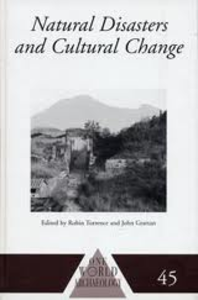Maritime archaeology and behaviour during crisis: the wreck of the VOC ship Batavia (1629)
Gibbs, Martin (2002) Maritime archaeology and behaviour during crisis: the wreck of the VOC ship Batavia (1629). In: Torrence, Robin, and Grattan, John, (eds.) Natural Disaster and Cultural Change. One World Archaeology, 45 . Routledge, London, UK, pp. 66-86.
![[img]](https://researchonline.jcu.edu.au/14375/1.hassmallThumbnailVersion/14375_Gibbs_2002_front_cover.jpg)
|
Image (JPEG) (Front Cover)
- Cover Image
Download (6kB) |
|
|
PDF (Published Version)
- Published Version
Restricted to Repository staff only |
Abstract
[Extract] Many of the chapters in this book and indeed most disaster studies emphasise the impact of a disaster on the environment and draw conclusions from their interaction as to the potential cultural response. Few actually address the direct cultural response to the hazard/disaster itself and it is in the nature of archaeological material that evidence for this is necessarily rare. This chapter throws light on the behaviour of one group of survivors; it is a gripping story of survivor mentality in an isolated community and the breakdown of established social order in the face of catastrophe.
Archaeological studies of disasters invariably address the consequences of catastrophes by investigating either natural site formation processes or the longterm impacts on settlement patterns, social systems, resource availability and trade. Discussion of human behaviour immediately before, during and after the crisis itself is primarily used as a device to add drama to the discussion or to emphasise the notion of disruption. Most archaeologists seem to implicitly dismiss human actions during the crisis as being somehow ephemeral, unfathomable ur, at worst, of little or no real consequence to the grand sweep of the archaeological story. Furthermore, crisis behaviour is considered to be unstructured and driven by panic. Shipwrecks, probably the class of disaster site most commonly investigated by archaeologists, are particularly susceptible to such lack of consideration. However, the heart of the crisis deserves serious study because it is during this time that nuny of the crucial decisions and actions that create the post-disaster archaeological record are taken.
Psychological studies of modern disasters have demonstrated that individual and group behaviour during crises is patterned and to some extent predictable. This paper will argue that a behavioural model developed from these studies can also be applied to the interpretation of past disaster events, providing a structure for the stages by which cultural and natural factors create or impact upon the archaeological record. It also proposes that many of these same behaviours can potentially be recognised in the archaeological record.
To illustrate this argument, the events leading to and following the 1629 wreck of the Dutch East India Company (VOC) vessel Batavia will be briefly examined. I show how the analysis of the documentary and archaeological data might be informed through an understanding of human behaviours during crisis. While this paper focuses on the relationship between a behavioural model and archaeological interpretation, a more detailed consideration of the archaeological signatures involved with shipwreck sites and survivor camps is provided elsewhere (Gibbs, in press).
| Item ID: | 14375 |
|---|---|
| Item Type: | Book Chapter (Research - B1) |
| ISBN: | 978-0-203-16510-2 |
| Keywords: | Abrolhos Islands; archaeology; Batavia; shipwreck survivors; shipwrecks; Western Australia |
| Related URLs: | |
| Date Deposited: | 16 Dec 2010 05:58 |
| FoR Codes: | 21 HISTORY AND ARCHAEOLOGY > 2101 Archaeology > 210199 Archaeology not elsewhere classified @ 100% |
| SEO Codes: | 97 EXPANDING KNOWLEDGE > 970116 Expanding Knowledge through Studies of Human Society @ 100% |
| Downloads: |
Total: 121 Last 12 Months: 9 |
| More Statistics |



